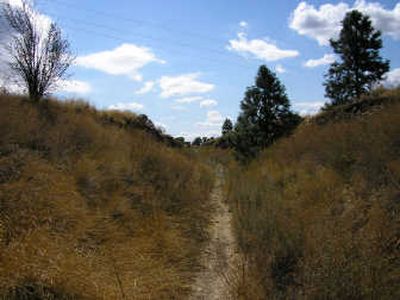Remains of the day

Railroads were vital to opening the Inland Northwest to the rest of the country and also for commerce within the region. Big and small, they moved people and material about, and the remnants of those now-defunct rail lines still mark the landscape today.
But they often aren’t recognized for what they are. The old Spokane and Inland Empire Railway, for example, is a good case in point. Portions of the rail bed are still evident, but they look like bike paths, trails, clearings, swales and just about everything but what they once were. And they’re all over the place on the Moran and Glenrose prairies.
For example, at the northern edge of the development south of 37th Avenue and Havana Street, the railroad’s path – obliterated by the development – reappears in the form of a trench, which measures some 15 feet deep and 30 feet wide. Overgrown with weeds, it is something of an improvised bike path for kids.
Steve Emerson, program director of Archaeological and Historical Services at Eastern Washington University, wrote an essay about the old Spokane and Inland Empire Railway, which once unified Glenrose and Moran prairies but which faded from the scene once automotive transport became more cost effective and The Great Depression devastated the economy. The railway once operated a 76-mile electrified line from Spokane to Colfax.
In his essay “Rails to the Palouse, A Photo Essay: Glenrose Prairie and Moran Prairie,” Emerson outlines the rise of the rail service from 1904 through its mergers and eventual demise in the 1940s, noting that most tracks and trestles were likely removed before 1960.
Attachments to the essay are photos of pastoral scenes which reveal unknown portions of the old rail system on which in 1910, “one could board a Spokane and Inland Empire Railway passenger car bound for the Palouse in downtown Spokane … The cars were powered by electricity provided by the Washington Walter Power Company, so the tracks were accompanied by electrical poles and cables, while the detachable connection called a pantograph provided the train with power.”
The essay describes an area that can still be driven on south of Ben Burr Boulevard and 57th Avenue, following much of the rail bed, “taking advantage of cuts and fills intended for the railroad.” There is description (and a photograph) of the end of a berm where a trestle had begun and “the now unbridgeable gap across the forested canyon.” He also speaks of one elevated section of earthen fill for the rail bed that can still be seen near where Harmon and Hilby roads intersect.
“Undoubtedly, more ghostly remains await the modern traveler with curiosity and an automobile,” Emerson writes.
This goes to show that there truly are landmarks of Inland Northwest history all around us. Sometimes we just need a little nudge or clue where to look.